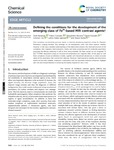Mostrar o rexistro simple do ítem
Defining the Conditions for the Development of the Emerging Class of Feᴵᴵᴵ-Based MRI Contrast Agents
| dc.contributor.author | Baranyai, Zsolt | |
| dc.contributor.author | Carniato, Fabio | |
| dc.contributor.author | Nucera, Alessandro | |
| dc.contributor.author | Horváth, Dávid | |
| dc.contributor.author | Tei, Lorenzo | |
| dc.contributor.author | Platas-Iglesias, Carlos | |
| dc.contributor.author | Botta, Mauro | |
| dc.date.accessioned | 2021-10-01T11:19:20Z | |
| dc.date.available | 2021-10-01T11:19:20Z | |
| dc.date.issued | 2021-07-26 | |
| dc.identifier.citation | 1 Z. Baranyai, F. Carniato, A. Nucera, D. Horváth, L. Tei, C. Platas-Iglesias and M. Botta, Chem. Sci., 2021, 12, 11138–11145. | es_ES |
| dc.identifier.issn | 2041-6539 | |
| dc.identifier.uri | http://hdl.handle.net/2183/28551 | |
| dc.description | Electronic supplementary information (ESI) available: Experimental details: thermodynamic, kinetic and redox studies. Equations used, NMRD profiles and DFT optimized structures. See DOI: 10.1039/d1sc02200h | |
| dc.description.abstract | [Abstract] Fe(III) complexes are attracting growing interest in chemists developing diagnostic probes for Magnetic Resonance Imaging because they leverage on an endogenous metal and show superior stability. However, in this case a detailed understanding of the relationship between the chemical structure of the complexes, their magnetic, thermodynamic, kinetic and redox properties and the molecular parameters governing the efficacy (relaxivity) is still far from being available. We have carried out an integrated ¹H and ¹⁷O NMR relaxometric study as a function of temperature and magnetic field, on the aqua ion and three complexes chosen as reference models, together with theoretical calculations, to obtain accurate values of the parameters that control their relaxivity. Moreover, thermodynamic stability and dissociation kinetics of the Fe(III) chelates, measured in association with the ascorbate reduction behaviour, highlight their role and mutual influence in achieving the stability required for use in vivo. | es_ES |
| dc.description.sponsorship | F. C., L. T. and M. B. acknowledge the financial support from Università del Piemonte Orientale (Ricerca locale FAR2019). C.P.-I. thanks Ministerio de Economía y Competitividad (CTQ2016-76756-P) and Xunta de Galicia (ED431B 2020/52) for generous financial support. C.P.-I. also thanks Centro de Supercomputación de Galicia (CESGA) for providing the computer facilities. Z. B. thanks the Doctoral School of Chemistry of the University of Debrecen for the PhD position of D. H. This work was carried out within the framework of the COST CA15209 Action “European Network on NMR Relaxometry” | es_ES |
| dc.description.sponsorship | Xunta de Galicia; ED431B 2020/52 | es_ES |
| dc.description.uri | https://www.rsc.org/suppdata/d1/sc/d1sc02200h/d1sc02200h1.pdf?_ga=2.73863058.1846997019.1635238700-352143482.1630049716 | |
| dc.language.iso | eng | es_ES |
| dc.publisher | Royal Society of Chemistry | es_ES |
| dc.relation | info:eu-repo/grantAgreement/AEI/Plan Estatal de Investigación Científica y Técnica y de Innovación 2013-2016/CTQ2016-76756-P/ES/NUEVA GENERACION DE AGENTES DE CONTRASTE PARA IMAGEN POR RESONANCIA MAGNETICA (IRM) ALTERNATIVOS A LOS DERIVADOS DE GADOLINIO/ | |
| dc.relation.uri | https://doi.org/10.1039/D1SC02200H | es_ES |
| dc.rights | Atribución-NoComercial 3.0 | es_ES |
| dc.rights.uri | http://creativecommons.org/licenses/by-nc/3.0/ | * |
| dc.title | Defining the Conditions for the Development of the Emerging Class of Feᴵᴵᴵ-Based MRI Contrast Agents | es_ES |
| dc.type | info:eu-repo/semantics/article | es_ES |
| dc.rights.access | info:eu-repo/semantics/openAccess | es_ES |
| UDC.journalTitle | Chemical Science | es_ES |
| UDC.volume | 12 | es_ES |
| UDC.issue | 33 | es_ES |
| UDC.startPage | 11138 | es_ES |
| UDC.endPage | 11145 | es_ES |
| dc.identifier.doi | 10.1039/D1SC02200H |
Ficheiros no ítem
Este ítem aparece na(s) seguinte(s) colección(s)
-
GI-REACT! - Artigos [107]






